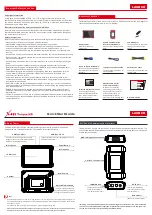
Range Switch Position
Maximum Pot Range Voltage/Interval (V/Oct)
1
0.333V, Major 3
rd
Interval
2
0.4167V, Perfect 4
th
Interval
3
0.583V, Perfect 5
th
Interval
4
0.666V, Minor 6
th
Interval
5
1V, One Octave
6
2V, Two Octaves
7
5V, Five Octaves
8
4V, Four Octaves, Variable
Table 7-3: A Suggested Range Selection Using the Internal Variable Range Option
This arrangement provides a wide range for position 8, yet provides enough resolution
that fairly precise intervals can be set using the Variable Range Control pot.
100K 0.1% Resistors
One other consideration should be given to the selection of the 100K resistor values. All
of the 100K resistors used on the Analogue Board are involved with mixing the voltages
as programmed on the programming pots. The Range Switch is set to certain intervals so
that the pots can be used more or less as switches, switching a specific interval into place
or not by turning the pot either full clockwise or anti-clockwise. The tolerance of the
mixing resistors will play a role in how accurately this is accomplished – this is why
0.1% resistors are specified.
0.1% resistors can be quite expensive. If you have them or can afford/acquire them, this
will make things much more cut and dried. If not, it is possible to match a set of resistors
to within 0.1%.
1% metal film resistors can be purchased quite inexpensively these days. Because of
that, it is possible to buy a large quantity of them for a relatively low price. If you
purchase a large quantity, you will more than likely find enough of them to be within
0.1% of their value as to be usable in this application.
So, if you don’t have the 0.1% 100K resistors, but have a big bag of 100K 1% resistors,
here’s what you do: pull out your DMM, and measure each and every resistor. Make
yourself a little pile of *exactly* each value. For example, you may have a pile of 99.6K
resistors, a pile of 99.7K resistors, etc. What you need are 25 resistors of the
same
value,
or, if you DMM has enough resolution, 25 resistors that are within 0.1% of the same
value. 0.1% of 100K is 100 Ohms, so that gives you an idea of how close to your central
value you need to be. Note, the value of your 25 resistors does not have to be 100K – it
can be 25 resistors within 99.7K or 100.4K or whatever.
The important thing is that all
25 resistors be within 0.1% of each other.
So, let’s begin our assembly, starting with the jumpers.
85
















































